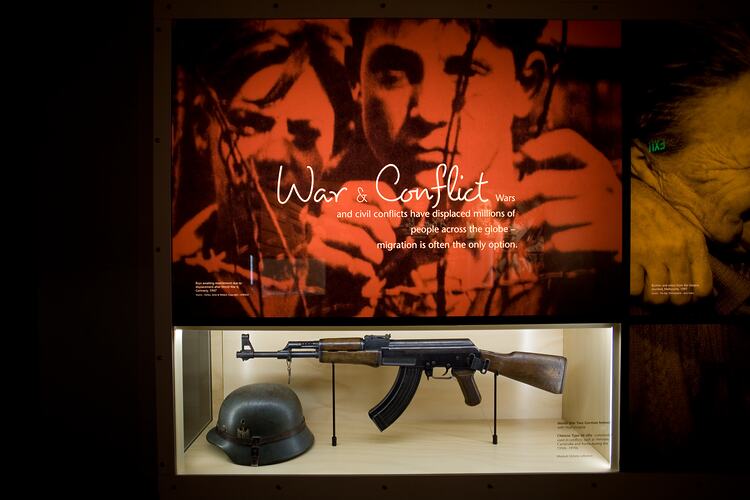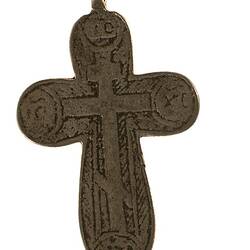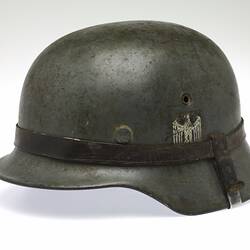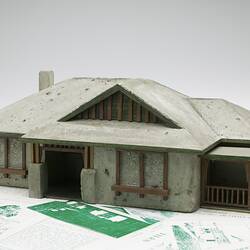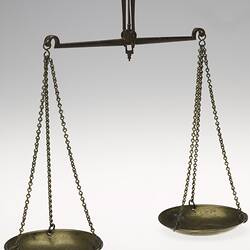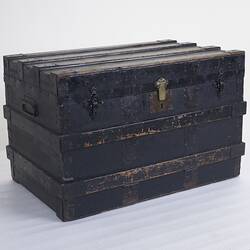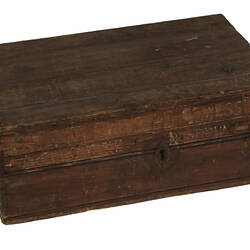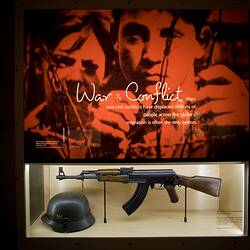Overview
Leaving home was the first in a series of four galleries exploring experiences of immigration to Victoria. It opened at the Immigration Museum in 2007 and finished in 2017.
The exhibition sets visitors on their journey through the museum by asking visitors to consider why people have left their homelands over time. It presented five main reasons: Family, War and Conflict, Disaster, Freedom, and a Better Life. These motivations cross time, place and peoples within a global context of migration and mass movement, highlighting both individual and collective experiences. The gallery presented the themes through iconic symbolic objects and images, a world globe containing broad migration facts, an evocative soundscape and the central experience: a large format film featuring still and moving images which evoked a full range of emotions including joy, sorrow, fear, relief, anger and despair. The film also included insights into the key motivations by Melburnians who have migrated from different countries, at different times and for very different reasons.
Further Exhibition Content
The Leaving home world globe provides the following animated general facts about migration that have had a significant impact upon Australia.
- Between 1788 and 1868, around 160,000 British and Irish convicts were transported to Australia.
- Between 1846 and 1939, 59 million people left Europe, bound mainly for North and South America, Australia, New Zealand and South Africa.
- Between 1851 and 1861, over half a million people - mainly from England, Ireland, Scotland, Wales, America, China and Germany - arrived in Victoria during the gold rush.
- By September 1939, 400,000 Jews had escaped Germany and Austria - 7,500 came to Australia.
- In 1947, around 3 million people remained displaced in war-torn Europe.By 1953, 170,000 had immigrated to Australia.
- By 1961, 1.3 million immigrants - mostly from Britain, Ireland, Italy, Greece, Poland, the Baltic states, Germany and the Netherlands - had arrived during Australia's post-war migration boom.
- Between 1975 and 2000, 1.75 million refugees fled war-ravaged Vietnam - around 170,000 came to Australia.
- There are 192 million people living outside their place of birth worldwide - 4 million live in Australia.
The Leaving home film presentation includes insights from the following people who have migrated to Victoria
- Violeta Veliz migrated to Melbourne from Chile in 1976. She and her husband arrived as refugees, escaping the political oppression of the Pinochet regime, which took over Chile via a military coup in 1973. Violeta left most of her family behind, with three of her siblings also fleeing Chile for Venezuela and Germany. Violeta learnt English and taught physical education in Footscray. She became instrumental in organising groups, particularly involving women, to fight for human rights in Chile and raise the profile of what was occurring there.
- Tonina Farugia migrated to Melbourne from Malta in 1956. She was 17 years old. She married by proxy as her father would not allow her to travel to Australia and meet up with her boyfriend unmarried (who had migrated in 1954). She came alone but was embraced by her husband's Teddy's large Maltese family in Australia. They settled in Coburg, then Brunswick and finally Lalor.
- Phong Nugyen migrated to Melbourne from Vietnam in 1979. He, his mother, two sisters and a brother arrived as refugees from post-war Vietnam, escaping their experiences of communist oppression. They escaped by boat and miraculously made it to an Indonesian refugee camp. Phong trained as a Jesuit priest in Sydney but was to leave the priesthood after relocating to Melbourne.
- Akoc Akuei Manhiem (pronounced Akoysh) migrated to Melbourne from Sudan in 2003. Akoc had to escape armed militia, having been separated from his family, and took almost a year to make it alone to Kenya. Southern Sudan was suffering under war, violence, famine and land degradation. In the refugee camp in Kakuma he became known as one of the 'lost boys', children who'd lost contact with their families and some of these boys were accepted by the US and then by Australia. There are high expectations on Akoc to support his broad family group still in southern Sudan and he is also a spokesperson for the Lost Boys in Australia.
- Shabbir Wahid migrated to Melbourne from Bangalore, India in 1982. He came on a temporary work visa to develop business opportunities between India, the Middle East and Australia. After four years Shabbir successfully sought permanent residency. He and his wife believed Australia offered great opportunity for themselves and their children, born in Australia, to reach their potential. Shabbir became the Australian consular-general and trade commissioner to India and he and his family have returned to India frequently for work but also to maintain their cultural connections.
Key Exhibition Objects
- Suitcase used by Giuseppe Minniti when he migrated from Limpidi, Italy on 23 March 1950. Luggage is a common part of the journey experience for migrants. However while some migrants are only able to bring the clothes on their back and a handful of treasured possessions, others bring almost everything they need to build a new life.
- Love Token made for William Adams as a memento to give to his sister before he was transported to Australia in 1834. Love Tokens were often commissioned by convicts before they were transported to Australia, as a memento for their loved ones. They serve as a reminder that while migration may unite family and lovers it can also tear them apart.
- Wooden ballot box used by the Commonwealth of Australia, circa 1900s-1930s.
- Gold Weighing Scales like these were used during the goldrushes of the 1850s in Victoria. During this time over half a million people came to Victoria seeking their fortunes and a better life.
- Chinese Type 56 Assault Rifle, circa 1960s
Related Collection Objects
- Miner's cradle
Miner's panning dish
- Rebecca Greaves Letter referencing the gold rush
- Gold mining Models
Objects featured in our long term exhibitions are changed over regularly both for preservation reasons and also to maintain a diverse representation of stories, communities and cultures. Both current and past Museums Victoria objects displayed in this exhibition are listed below.
More Information
-
Keywords
Museum Victoria Exhibitions, Immigration Selection, Assisted Immigration, Immigration Policies, Immigration Debates, Immigration, Immigration Voyages
-
Authors
-
Article types
